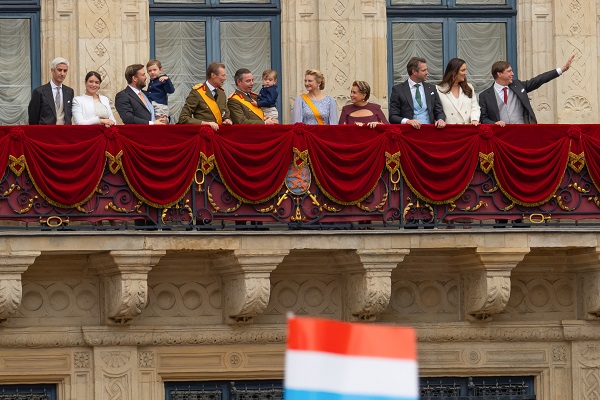 Members of the Grand Ducal family on the balcony of the Grand Ducal Palace, Luxembourg City, 3 October 2025;
Credit: Ali Sahib, Chronicle.lu
Members of the Grand Ducal family on the balcony of the Grand Ducal Palace, Luxembourg City, 3 October 2025;
Credit: Ali Sahib, Chronicle.lu
Luxembourg is a constitutional monarchy that recognises a hereditary monarch (either a Grand Duke or Grand Duchess) as its head of state, although this role is largely ceremonial.
The title is passed down among the direct descendants of Grand Duke Adolphe, Duke of Nassau. Today, Luxembourg is the only remaining grand duchy in the world.
Historical Background
Luxembourg has passed through the hands of several European dynasties over the centuries. It became a Grand Duchy in 1815 as a result of the Congress of Vienna, which placed it in a personal union with the Netherlands under King William (Wilhelm) I of Orange-Nassau.
Following the Belgian Revolution, which broke out in 1830, the Treaty of London of 1839 divided Luxembourg’s territory into two entities: the Grand Duchy of Luxembourg, which remained under Dutch rule, and Belgian Luxembourg, which became a province of Belgium. The Treaty of London of 1867 then redefined the status of the Grand Duchy, formally establishing its neutrality; the treaty also reaffirmed ties with the House of Orange-Nassau and recognised the succession rights of the agnates (male-line descendants from a common ancestor) of the House of Nassau.
The Grand Duchy of Luxembourg became fully independent in 1890 after the death of King William III of the Netherlands. As his daughter, Wilhelmina, was barred from inheriting the Luxembourgish crown due to male-only succession rules, the throne passed to Duke Adolphe of Nassau-Weilburg, establishing Luxembourg’s reigning dynasty.
Early 20th Century
Grand Duke Adolphe’s granddaughter, Marie-Adélaïde (1894-1924), became Luxembourg’s first reigning Grand Duchess in 1912, following the death of her father, Grand Duke William (Guillaume) IV, who had no sons. To enable her succession, Luxembourg altered the relevant law in 1907 to allow for female rulers. Marie-Adélaïde assumed the throne at just seventeen years old. However, her reign was relatively short and marred by controversy. During World War I, Luxembourg was occupied by Germany and, although Marie-Adélaïde maintained a stance of official neutrality, she was accused of pro-German sympathies. Her political involvement and conservative views also led to increasing public and political dissatisfaction. Amid growing pressure, she abdicated in January 1919 in favour of her younger sister, Charlotte. Marie-Adélaïde subsequently retired to a convent in Italy but later left due to ill health; she died of influenza in Germany in January 1924, aged 29.
Grand Duchess Charlotte (1896-1985) ascended the throne during a time of political uncertainty. A referendum held in September 1919 gave her stronger democratic legitimacy: about 77% of voters chose to retain the monarchy, under her rule, rather than forming a republic.
During World War II, Grand Duchess Charlotte became a symbol of national resistance. Forced into exile during the Nazi occupation, she broadcast radio messages to the Luxembourg public from London via the BBC. She also met with US President Franklin D. Roosevelt and travelled across the United States to rally support for the Allied war effort. On 14 April 1945, she returned to Luxembourg to an enthusiastic crowd. She ruled until November 1964 when she abdicated in favour of her son, Jean.
Grand Duke Jean (1921-2019) led Luxembourg through a period of economic modernisation and deeper European integration. In 2000, he abdicated after a 36-year reign, passing the crown to his son, Henri. During WWII, Jean had volunteered to join the Irish Guards (British Army) and he took part in the D-Day landings in Normandy in June 1944, as part of a reinforcement unit. Grand Duke Jean passed away on 23 April 2019, after falling ill with pneumonia. The Luxembourg government declared a ten-day national mourning period, which culminated in a well-attended official funeral at Notre-Dame Cathedral in the capital on 4 May 2019.
Present Day
Henri became Grand Duke of Luxembourg on 7 October 2000. Born on 16 April 1955, he is the eldest son of Grand Duke Jean and Grand Duchess Joséphine-Charlotte. On 14 February 1981, Henri married Cuban-born Maria Teresa Mestre at Luxembourg’s Notre-Dame Cathedral.
In summer 2024, news broke that the couple’s eldest son, Prince Guillaume, Hereditary Grand Duke, would be designated “Lieutenant-Représentant” (Lieutenant-Representative) of the Grand Duke. This appointment took effect on 8 October 2024, when Guillaume became the first Hereditary Grand Duke to take the lieutenancy oath before the full Chamber of Deputies (Luxembourg’s parliament) in a public session - a historic moment which parliament president Claude Wiseler described as “the confluence of tradition and renewal”.
Later that year, in his Christmas speech, Grand Duke Henri announced plans to abdicate in October 2025, marking the end of a 25-year reign. His son Guillaume ascended the throne on 3 October 2025.
Born on 11 November 1981, then-Hereditary Grand Duke Guillaume married Countess Stéphanie de Lannoy at Notre-Dame Cathedral on 20 October 2012. They have two sons: Prince Charles, who was born on 10 May 2020 and, as of October 2025, is first in line to the throne; and Prince François, born on 27 March 2023 and second in line.
Grand Duke Guillaume has four siblings:
- Prince Félix (born in 1984), married to Claire Lademacher (Princess Claire) with whom he has one daughter, Princess Amalia (2014), and two sons, Prince Liam (2016) and Prince Balthazar (2024);
- Prince Louis (born in 1986), father of two sons, Prince Gabriel (2006) and Prince Noah (2007), through his first marriage to Tessy Antony;
- Princess Alexandra (born in 1991), married to Nicolas Bagory with whom she has one daughter, Victoire (2024), and one son, Hélie (2025);
- Prince Sébastien (born in 1992).
Official Residences
The Grand Ducal Palace in Luxembourg City continues to serve as the Grand Duke’s official residence and workplace, hosting state ceremonies, audiences and official receptions. A raised flag signals when the Grand Duke is present. The current site was once home to Luxembourg City’s town hall, built around 1418. In 1890, the main building became the exclusive residence of Grand Duke Adolphe. During the Second World War, German occupying forces seized the building and converted it into a concert hall and tavern. The palace underwent major renovation work in the 1990s. It is open to the public for guided tours in summer.
Berg Castle in Colmar-Berg functions as the Grand Ducal couple’s private residence. During World War II, the Nazis established an elite school for girls in the castle, and the resulting alterations caused significant damage. Restoration work was carried out after the war, during which time Grand Duchess Charlotte and her family relocated to Fischbach Castle until 1964. From 1964 to 2000, Grand Duke Jean and Grand Duchess Joséphine-Charlotte resided at Berg Castle, followed by their successors Grand Duke Henri and Grand Duchess Maria Teresa. In 2024, while still Hereditary Grand Duke, Guillaume announced plans for a privately funded annexe to the existing castle to create a more intimate home for his family - a move reflecting a generational shift toward modernisation.
Fischbach Castle is another royal residence of notable historical significance. During the Nazi occupation, it was used as a rest home for German artists. As with the other castles, many artworks and furnishings were looted during this time. Fischbach Castle is said to have been the favourite residence of Grand Duchess Charlotte after the war. Henri and Maria Teresa, in their roles as Hereditary Grand Duke and Hereditary Grand Duchess, lived there between 1987 and 2000 before moving to Colmar-Berg. The retiring Grand Duke Jean and Grand Duchess Joséphine-Charlotte moved into Fischbach in 2002. Then-Hereditary Grand Duke Guillaume and Hereditary Grand Duchess Stéphanie resided at Fischbach Castle between 2019 (the year of Grand Duke Jean’s death) and 2025. They will move to Colmar-Berg as Grand Duke and Grand Duchess, with Henri and Maria Teresa expected to retire to Fischbach.
Constitutional Changes and Modernisation
A key moment in Luxembourg’s political history took place in 2008, when Grand Duke Henri expressed moral objections to signing a euthanasia bill into law. As a result, Luxembourg’s parliament amended the constitution to remove the requirement for the reigning monarch’s formal assent on laws. The major reform helped avert a constitutional crisis.
In 2011, the Grand Ducal Court introduced a new internal regulation establishing absolute primogeniture. This reform aimed to ensure gender equality in the line of succession for Grand Duke Henri’s descendants, meaning the eldest child, regardless of gender, may inherit the throne.
In 2020, the Luxembourg government commissioned the Waringo Report, led by former civil servant Jeannot Waringo, to examine the internal functioning of the Grand Ducal Court. The resulting 44-page report cited concerns about management practices and transparency. Its findings prompted steps toward greater accountability and modernisation of the Court’s administration.
In July 2023, the new Constitution of Luxembourg came into force after nearly two decades of debate and review. Among other changes, the revised text formally detailed the procedures for accession, abdication and regency, and removed all reference to the Nassau Family Pact. It also clarified the framework for annual state allocations to the Grand Duke and Hereditary Grand Duke.
Finances
The Grand Ducal household (Maison du Grand-Duc) reports its annual expenditure as part of transparency efforts. In 2024, spending amounted to nearly €19.4 million, representing 87% of the initial budget of €22.3 million. These costs cover staffing, public events and activities, royal family allowances and other related expenses.
The "Trounwiessel" festivities, celebrating the recent change of reign in Luxembourg, added a one-off expense of over €8.6 million.
Royal Connections
Luxembourg’s Grand Ducal Family is related to several European royal houses, including the British Royal Family. Grand Duke Henri and King Charles III are distant cousins (reportedly through shared descent from King George II and Queen Caroline). Grand Duke Henri attended King Charles’ coronation in May 2023. More recently, royals from Belgium and the Netherlands attended the accession of Grand Duke Guillaume. These dynastic ties highlight Luxembourg’s place in the broader history of Europe’s royal families.








